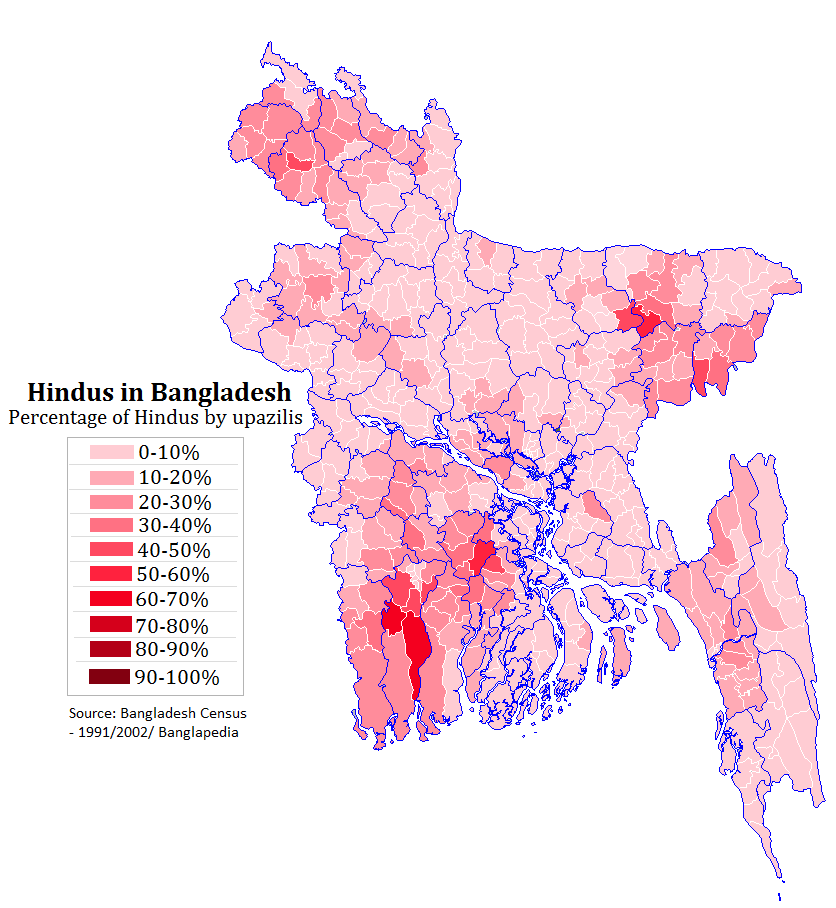|
Kishoreganj District
Kishoreganj ( bn, কিশোরগঞ্জ) is a district in Dhaka Division, Bangladesh. Earlier it was a Mohkuma (মহকুমা) under the Mymensingh district. It was taken 2495.07 sq. km of land from Mymensingh district to form present day Kishoreganj District. Kishorganj consists of eight municipalities, 13 upazilas, 105 union parishads, 39 wards, 145 mahallas, 946 mouzas and 1775 villages. Administration * Deputy Commissioner: Md Sarwar Murshed Chowdhury * Additional Deputy Commissioner (Overall): Tarfdar Md. Aktar Jamil * Additional Deputy Commissioner (Tax): Dulal Chandra Sutradhar * Additional Deputy Commissioner (Education and Information and Communication Technology): Golam Mohammad Bhuiyan * Additional District Magistrate: Alamgeer Hosain Subdistricts/Upazilas Demographics According to the 2011 Bangladesh census, Kishoreganj District had a population of 2,911,907, of which 1,432,242 were males and 1,479,665 were females. Rural population was 2,422,877 ... [...More Info...] [...Related Items...] OR: [Wikipedia] [Google] [Baidu] |
Kishoreganj Sadar Upazila
Kishoreganj Sadar ( bn, কিশোরগঞ্জ সদর) is an upazila of Kishoreganj District in the Division of Dhaka, Bangladesh. It is best known as the home upazila of Syed Nazrul Islam, an Acting President of Bangladesh. Geography Kishoreganj Sadar is located at . It has 55,828 housing units and a total area 193.73 km2. Kishoregonj is the name of a district where some important people were born. Kishoreganj Sadar Upazila (kishoreganj district) is bounded by Nandail upazila on the north, Pakundia and Katiadi upazilas on the south, Karimganj and Tarail upazilas on the east and Hossainpur and Nandail upazilas on the west. The principal river is the Narsunda. Demographics As of the 1991 Bangladesh census, Kishoreganj Sadar had a population of 300,337. Males constituted 51.52% of the population, females 48.48%. This upazila's population of eighteen and older was 149,926. Kishoreganj Sadar had an average literacy rate of 28.3% (7+ years). The national average was 32.4% ... [...More Info...] [...Related Items...] OR: [Wikipedia] [Google] [Baidu] |
Hinduism In Bangladesh
Hinduism is the second largest religious affiliation in People's Republic of Bangladesh, as according to the Official 2022 Census of Bangladesh, approximately just 13.1 million people responded that they were Hindus, constituting 7.95% out of the total population of 165.15 million people. In terms of population, Bangladesh is the third-largest Hindu populated country of the world, just after India and Nepal. Hinduism is the second-largest religion in 61 out of 64 districts of Bangladesh, but there is no Hindu majority district in Bangladesh. Culture In nature, Bangladeshi Hinduism closely resembles the forms and customs of Hinduism practiced in the neighboring Indian state of West Bengal, with which Bangladesh (at one time known as East Bengal) was united until the partition of India in 1947. The vast majority of Hindus in Bangladesh are Bengali Hindus. Goddess ( Devi) – usually venerated as Durga or Kali – is widely revered, often alongside her consort Shiva. The w ... [...More Info...] [...Related Items...] OR: [Wikipedia] [Google] [Baidu] |
Islam In Bangladesh
Islam is the state religion of the People's Republic of Bangladesh. According to the 2022 census, Bangladesh had a population of about 150 million Muslims, or 91.04% of its total population of million. The majority of Bangladeshis are Sunni, and follow the Hanafi school of fiqh. Religion is an integral part of Bangladeshi identity. Despite being a Muslim-majority country, Bangladesh is a ''de facto'' secular state. In the 9th century, Arab Muslims established commercial as well as religious connection within the region before the conquest, mainly through the coastal regions as traders and primarily via the ports of Chittagong. Region was largely inhabited by different animistic tribes. Arab navigation in the region was the result of the Muslim reign over the Indus delta. In the early 13th century, Muhammad bin Bakhtiyar Khalji conquered Western and part of Northern Bengal, and established the first Muslim kingdom in Bengal. Islamic missionaries in India achieved their greatest ... [...More Info...] [...Related Items...] OR: [Wikipedia] [Google] [Baidu] |
Bangladesh Bureau Of Statistics
The Bangladesh Bureau of Statistics (BBS) is the centralized official bureau in Bangladesh for collecting statistics on demographics, the economy, and other facts about the country and disseminating the information. History Although independent statistical programs had existed in the country before, they were often incomplete or produced inaccurate results, which led the Government of Bangladesh establishing an official bureau in August 1974, by merging four of the previous larger statistical agencies, the Bureau of Statistics, the Bureau of Agriculture Statistics, the Agriculture Census Commission and the Population Census Commission. In July 1975, the Statistics and Informatics Division was created under the Planning Ministry (Bangladesh) and tasked to oversee the BBS. Between 2002 and 2012, the division remained abolished but was later reinstated. The Bangladesh Bureau of Statistics is headquartered in Dhaka Dhaka ( or ; bn, ঢাকা, Ḍhākā, ), formerly ... [...More Info...] [...Related Items...] OR: [Wikipedia] [Google] [Baidu] |
2011 Bangladesh Census
In 2011, the Bangladesh Bureau of Statistics, conducted a national census in Bangladesh, which provided a provisional estimate of the total population of the country as 142,319,000. The previous decennial census was the 2001 census. Data were recorded from all of the districts and upazilas and main cities in Bangladesh including statistical data on population size, households, sex and age distribution, marital status, economically active population, literacy and educational attainment, religion, number of children etc. Bangladesh and India also conducted their first joint census of areas along their border in 2011. According to the census, Hindus constituted 8.5 per cent of the population as of 2011, down from 9.6 per cent in the 2001 census. Bangladesh have a population of 144,043,697 as per 2011 census report. Majority of 130,201,097 reported that they were Muslims, 12,301,331 reported as Hindus, 864,262 as Buddhists, 532,961 as Christians and 201,661 as others. See also * ... [...More Info...] [...Related Items...] OR: [Wikipedia] [Google] [Baidu] |
Bhairab Upazila
Bhairab ( bn, ভৈরব) is a upazila of Kishoreganj District in the Division of Dhaka, Bangladesh. Joanshahi was another name of Bhairab. The city centre of this upazila is Bhairab Bazaar. About 118,992 people live in Bhairab municipality which makes this city the largest in Kishoreganj District and 28th largest city in Bangladesh. Geography Bhairab is located at . It has 34,419 households and total area is 139.32 km2. Bhairab is situated beside the rivers of Meghna and Brahmaputra. Bhairab Bazar (town) is notable for the Bhairab railway station and the railway bridge, Bhairab bridge that goes over the river of Meghna. Demographics As of the 2011 Bangladesh census, Bhairab has a population of 298309. 115498 of total population live in Municipality area. Males constitute 49.25% of the population, and females 50.74%. This Upazila's eighteen up population is 95,910. According to the 1991 Bangladesh census, Bhairab has an average literacy rate of 36.23% (7+ years) where t ... [...More Info...] [...Related Items...] OR: [Wikipedia] [Google] [Baidu] |
Mithamain Upazila
Mithamoin ( bn, মিঠামইন, Mithamoin) is an upazila (subdistrict) of Kishoreganj District in northern Bangladesh, located in the Dhaka Division. It is best known as the home upazila of Abdul Hamid, the current President of Bangladesh. Geography Mithamoin is located at . Mithamoin has 17,183 households and a total land area of 222.92 km2. History The area has been inhabited for centuries. The name of Mithamain can be found in James Rennell's 1781 map of Bengal. The upazila was named after the village of Mithamain. Its etymology is rumored to be that at one time there was a large reed forest in the vicinity of the area. The reed was sweet, and the name of the village came to Mithabon (মিঠাবন ''sweet forest'') which was corrupted to Mithamon and later Mithamain/Mithamoin in the local dialect. During the Bangladesh Liberation War of 1971, 28 Bengalis were murdered in the village of Dhubajura and 3 in Telikhai on 1 November. Boira was a site of mass killing ... [...More Info...] [...Related Items...] OR: [Wikipedia] [Google] [Baidu] |
Nikli Upazila
Nikli ( bn, নিকলি) is an upazila of Kishoreganj District in the Division of Dhaka, Bangladesh. Geography Nikli is located at . It has 22,008 households and total area 214.4 km2. Demographics As of the 1991 Bangladesh census, Nikli has a population of 110,912. Males constitute 50.16% of the population, and females 49.84%. This Upazila's eighteen up population is 54,437. Nikli has an average literacy rate of 12.6% (7+ years), and the national average of 32.4% literate. Administration Nikli Upazila is divided into seven union parishads: Chatir Char, Dampara, Gurai, Jaraitala, Karpasha, Nikli, and Singpur. The union parishads are subdivided into 46 mauzas and 125 villages. See also *Upazilas of Bangladesh An ''upazila'' ( bn, উপজেলা, upôzela, lit=sub-district pronounced: ), formerly called ''thana'', is an administrative region in Bangladesh, functioning as a sub-unit of a district. It can be seen as an analogous to a county or a ... * Districts o ... [...More Info...] [...Related Items...] OR: [Wikipedia] [Google] [Baidu] |
Itna Upazila
Itna ( bn, ইটনা) is an upazila of Kishoreganj District in the Division of Dhaka, Bangladesh. History In 1864, a police outpost was founded in the village of Badla, 6 km west of Itna Sadar. This outpost was disestablished on 15 June 1906 following the gazette notification 6676 which announced that a full-fledged thana (police station) would be established in Itna. Khwaja Hafizullah, founder of the Dhaka Nawab family, purchased some land in Itna Pargana. During the Bangladesh Liberation War of 1971, a number of people were killed in the village of Boira in Joysiddhi Union. Geography Itna is located at . It has 23943 households and total area 401.94 km2. Economy and tourism There are many local mysteries about the construction of Itna Madhyagram Jame Masjid, which has gained the status of ''gayebi masjid'' and made it a place of attraction. The dargah of the five pirs in Mirdhahati as well as the Badshahi Mosque are also popular places in Itna. Demographics As o ... [...More Info...] [...Related Items...] OR: [Wikipedia] [Google] [Baidu] |
Tarail Upazila
Tarail ( bn, তারাইল) is an upazila of Kishoreganj District in the Division of Dhaka, Bangladesh. Geography Tarail is located at . It has 23232 households and total area 136.88 km2. Demographics As of the 1991 Bangladesh census, Tarail has a population of 138488. Males constitute 50.41% of the population, and females 49.59%. This Upazila's eighteen up population is 62143. Tarail has an average literacy rate of 17.5% (7+ years), and the national average of 32.4% literate. Administration Tarail Upazila is divided into Tarail Municipality and seven union parishads: Damiha, Dhala, Digdair, Jawar, Rauti, Talganga, and Tarail Sachail. The union parishads are subdivided into 75 mauzas and 116 villages. See also * Upazilas of Bangladesh An ''upazila'' ( bn, উপজেলা, upôzela, lit=sub-district pronounced: ), formerly called ''thana'', is an administrative region in Bangladesh, functioning as a sub-unit of a district. It can be seen as an analogous to a c ... [...More Info...] [...Related Items...] OR: [Wikipedia] [Google] [Baidu] |
Katiadi Upazila
Katiadi ( bn, কটিয়াদি) is an upazila of Kishoreganj District in the Division of Dhaka, Bangladesh. Geography Katiadi has an area of . Katiadi Upazila is the largest upazila of Kishoreganj district, with an area of 219.22 km2. It is bounded by Kishoreganj Sadar and Karimganj Upazilas on the north, Belabo and Monohardi upazilas on the south, Nikli and Bajitpur upazilas on the east, and Pakundia Upazila on the west. Purushbadhia, Doba and Reksa Beels are notable. Demographics As of the 1991 Bangladesh census, Katiadi had a population of 264,501, across 49,488 households. Males constituted 50.24% of the population and females 49.76%. The number of adults over the age of 18 is 125,001. Katiadi had an average literacy rate of 20.3% (7+ years), compared to the national average of 32.4%. Street and railway There have many Street in this upazila. Also have two railway station in Katidai Administration Katiadi thana became an upazila in 1983. Katiadi was declared ... [...More Info...] [...Related Items...] OR: [Wikipedia] [Google] [Baidu] |



